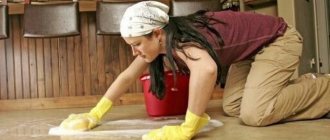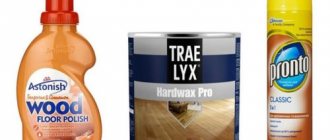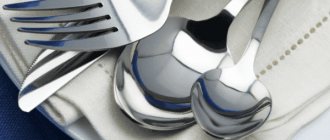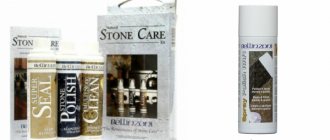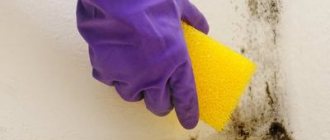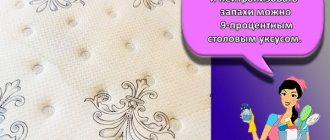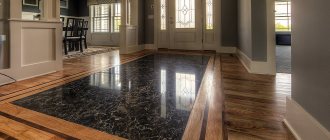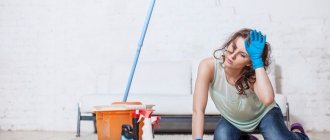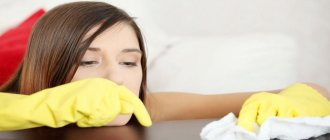What to wash with
After painting, the floor is washed off with warm water for a week after all layers have dried. The most suitable means for this are homemade sour kvass or ordinary vinegar.
Vinegar
To prepare the mixture to wash the floor, add no more than 1 cup of table vinegar to warm water (5 liters). After this, the product will be completely ready to wash the painted floor.
- Sweep or vacuum the surface, removing all debris.
- Fill a spray bottle with the prepared mixture. Spray it all over the floor.
- Wipe the floor using a mop and cloth.
- The final step is to wipe the floor dry with a dry cloth that absorbs water well.
Homemade sour kvass
After painting, the floor can be washed with homemade kvass. Dissolve kvass (1 l) in a bucket of hot water. It is better if it is very sour. The coating is washed with this solution several times every day for 7 days. If you treat the floor with this product, it becomes more shiny and its service life becomes longer.
We choose from 7 candidates
There are seven models to choose from. Let's briefly look at the characteristics of each.
Rag mop. The simplest option, otherwise called “lazy woman”. The wooden base with a rag in the shape of the letter T has been tested for many years of use. It's inexpensive.
- Butterfly mop. It is equipped with a spin mechanism, which is why it received such an unusual name. Convenient in small size, helps remove pet hair. You need to be careful with a mechanism that breaks easily.
- Rope. The long handle is equipped with a mop with ropes. The raw material for them is cotton, which absorbs moisture well, viscose or microfiber. This tool makes it easy to remove moisture from the floor. In addition, the attachment can be washed in a washing machine. Suitable for linoleum, but not capable of collecting pet hair.
Rope
- Steam. Does not leave streaks and completely absorbs moisture. In fact. This is a type of household appliance like a washing vacuum cleaner. The advantage is that steam has a disinfecting effect.
- Microfiber mop. A simple design with a telescopic handle and a platform on which microfiber is located. The platform is connected using a hinged installation, which allows you to change the position of the platform and makes cleaning easier, allowing the mop to penetrate even the most difficult to reach places. Microfiber absorbs moisture well and collects animal hair. The rag can be washed on a delicate cycle in a washing machine.
Microfiber pad
- Sponge nozzle and spin function. This floor cleaning tool is equipped with a sponge attachment and a special handle for squeezing. It's easy to use because you don't have to bend and it takes a little effort to wring out the soft sponge. Cleaning is done with clean hands; there is no need to touch the water, which allows the use of disinfectants that cause skin irritation. Absorbs moisture perfectly and does not leave streaks. I am also pleased with the reasonable price for such mops.
- Flounder. Similar to microfiber nozzles, but there are a number of distinctive features. The nozzle can be made of cotton or polyester. This tool is used to wash both floors and walls and ceilings. The aluminum handle makes it easy to wring out the nozzle and wash the ceiling structures without much effort. Spinning is performed by pressing a special pedal, so there is no need to touch the nozzle itself. Professional cleaning companies use this tool, and it is expensive.
Flounder
Which mop is best for cleaning linoleum? There is no single winner here, because all types of this tool allow you to perform wet cleaning without marks or streaks. If you don’t know which mop to choose, focus on the price.
Among all, we can highlight the flounder, mops with microfiber and a sponge attachment. They are light and comfortable, easy to wash under furniture and in corners of the room. In this case, you do not have to manually squeeze the nozzle. This feature is important when special disinfectants are used.
https://youtube.com/watch?v=ZrDbZWbR2rk
Washing instructions
Before washing the floor after painting it, you will need to make sure that the paint is completely dry. You can find out how long the paint chosen for painting will take to dry by reading the instructions on the jar in which it is sold. The manufacturer indicates the period of time during which one layer of paint and varnish dries. If there is no such information, in any case you cannot wash the floor earlier than after a week.
Treating the painted surface with homemade kvass or vinegar will not be enough. It needs regular cleaning and washing. And sometimes you need to rub it until it shines.
To maintain the original appearance of the floor, you must adhere to some rules:
- carry out regular wet cleaning to prevent numerous mechanical damages due to exposure to dirt, sand and dust;
- for dry cleaning with a vacuum cleaner, you need to take attachments with a brush with soft bristles; using a hard brush can cause mechanical damage and scratches;
- Do not use products with chemical components or solutions with soap, as this may cause the coating to peel off, and the paint will fade and lose its shine.
Wet cleaning of a painted floor is not a difficult or time-consuming task. Its implementation makes it easier to care for the coating in the future.
What to consider
Any problem is solved taking into account the type of board, its coating and the type of contamination.
The parquet floor should not be wetted with water, otherwise it will quickly become unusable.
Excessive moisturizing is unacceptable
, even if the planks are varnished, since the parquet floor is laid from equally small planks. They are tightly fitted one to another. This cladding on a concrete or wood base has many joints that trap water and eventually destroy the wood.
The “For Parquet” product will provide high-quality cleaning and will not damage the expensive wooden flooring.
The means are also selected specially
- specifically for parquet. They form a shiny protective film, polish the boards and close cracks.
Varnished plank floors also require a special approach to cleaning.
And the boardwalk is made from large boards. Their sizes are different. And in order to clean the plank floor, its own nuances are taken into account. Namely, whether it is painted or not. Therefore, caring for wood flooring also depends on its treatment:
All joints can be cleaned with a regular vacuum cleaner with a floor attachment.
- First you need to vacuum the floor
, that is, use dry washing. This applies to all wood flooring. After all, it is very difficult to wash out dust in cracks and joints, even using the most effective cleaning agent; - Then wet cleaning
of the wood floor begins.
Rules of care
Caring for a painted floor should not be limited to wet cleaning using vinegar or homemade kvass. You will need to regularly clean the surface from dust, wash it and gently rub it without applying any serious physical effort. Such events will be useful not only for coverage, but also for the health of the people who are in this room.
In order not to spoil the painted coating and not harm your health, you must adhere to the following rules for caring for it:
- The use of a special emulsion that makes the floor shiny will help protect the surface and improve its appearance. Use this product by spraying a dust-free surface. After this, the emulsion is rubbed with a clean piece of cloth or using a sponge. The emulsion is applied in several layers (no more than twice during the month).
- After washing the painted areas with a vinegar solution, you can rub it with a special product containing mastic, or use wax. When the treated coating is completely dry, a glossy film appears on it. It not only gives the floor an attractive appearance, but also additionally protects it.
- When wet cleaning, it is allowed to use a special solution prepared by hand. To do this, add a few tablespoons of ammonia to a 10-liter bucket. If you use this mixture, the coating will have an attractive shine for a long time.
- To clean a painted floor, you should use a vacuum cleaner to make it easier to get rid of dust in hard-to-reach places (cleaning pores and crevices).
- It is recommended to carry out daily wet cleaning. To do this, use a regular damp cloth. You will need to pay special attention to those places where the greatest amount of dirt accumulates (under furniture).
How to wash linoleum to make it shine - Helga's Blog
Linoleum is considered one of the most affordable floor coverings. Durable and functional material has a huge selection of colors, it is easy to install, and most importantly, many believe that it is very easy to care for. Indeed, by laying linoleum in your house, you can forget about a number of problems. Of course, if you know how to properly wash such a coating, what products to use for cleaning, and what compounds should not be used under any circumstances. It's sad but true: improper care can harm any, even the most durable coating in your home!
How to properly wash linoleum
Like any floor covering, linoleum needs to be washed regularly. Otherwise, you will inevitably experience a sticky floor effect. Don't want to feel like a fly whose legs are stuck to a jar of honey? Then let's start cleaning.
1. Remove sand and debris
First, remove sand and dry dirt from the floor using a brush or vacuum cleaner. As with any other coating, scratches may appear on linoleum, which will contribute to its destruction.
2. Use a microfiber cloth
No matter how durable linoleum may seem, it still does not like excess moisture. Therefore, it is advisable not to wash the floor with a wet cloth immediately after laying. Cleaning linoleum is carried out using a well-wrung microfiber cloth.
3. Wash with soap and water carefully.
In order to thoroughly wash linoleum, plain water may not be enough. However, if you use a soap solution, remember that the alkali it contains can damage the floor covering. This means that such a solution must be washed off as quickly as possible.
4. We use protective compounds
A floor that is regularly subjected to heavy traffic must not only be cleaned, but also protected. Otherwise, the coating will quickly lose its attractive shine. That is why soap solution is not enough here. It is advisable to use a special cleaner for linoleum. Its gentle formula not only cleans the floor, but also creates a protective layer on its surface, which, if used regularly, will protect the coating and prevent its wear.
5. Select HG
Cleaning and polishing agent for linoleum and vinyl coverings HG carefully cares for linoleum and also protects it from damage, giving the coating an excellent shine. In this case, there is no need to diligently rub the floor with a cleaning composition. In order to get an excellent result, you just need to effortlessly wipe the floor with a cloth soaked in the diluted product, then dry the floor and lightly polish it for a special shine.
How to clean linoleum from difficult stains
Don't even try to get rid of stubborn stains with acids or abrasives. Kerosene, soda, ammonia or gasoline can harm linoleum. A damaged coating will retain dirt, becoming covered with stubborn stains that are difficult to get rid of. Cleaner for linoleum and vinyl coverings HG can easily cope with complex stains. The product will effectively remove any stubborn dirt and stains, and also thoroughly clean the flooring without damaging its structure. HG can also be used to remove old layers of polish. You just need to dilute the product in the required proportion, and then wash the floor with the resulting composition. In areas with complex stains, it is advisable to leave the product to act for several minutes. After HG has thoroughly cleaned the linoleum, a protective compound can be applied to it.
Following these rules will help you keep your flooring in excellent condition for many years to come. There is no need to make an effort. With HG, the question of how to clean linoleum is solved in a very simple way, and cleaning becomes a real pleasure!
Why wash the floor after painting?
The new coatings are completely clean and shiny. It seems that cleaning them is completely unnecessary. This is true for most varnishes and other products used to coat indoor surfaces: they do not require additional processing.
Floors painted with oil dyes must go through the preparation stage for use. These environmentally friendly materials are made from natural ingredients. They do not have a suffocating odor and are pleasant to work with. They last up to 5-7 years and have a low cost.
But oil paints have one significant drawback: they take a very long time to dry, some require 5 to 7 days to dry completely, for this reason they are rarely used now.
The main component of oil paints is drying oil; it is usually made on the basis of natural oils, with the addition of pigments. Also, artificially synthesized ingredients or combinations thereof can be used in production. Therefore, after drying, a thin greasy layer appears on the surface. This is what needs to be removed. This action will prevent feet and other objects from sticking to the floor, will give the surface an attractive, shiny appearance, facilitate further maintenance and extend its service life.
Slightly acidic solutions of vinegar or homemade kvass added to warm water will help clean floors from the oil layer.
Do not wash a painted floor for the first time using detergents or soda. These components will destroy the surface layer of fresh paint, it will fade and may even begin to peel off.
How to remove grease stains
Grease stain – quite often appears on walls, especially near doors and switches:
- A fresh greasy stain can be easily removed from non-woven and vinyl wallpaper. To do this, just rub it with a damp cloth. Such materials have a water-repellent layer that prevents deep penetration of dirt and makes it easy to get rid of greasy stains with water and detergent. The product is diluted in water 1:10, a sponge is moistened with it and the stain is wiped, after which it is blotted with a paper napkin. Old stains are removed with a toothbrush.
- Grease stains can be easily removed from paper wallpaper with tooth powder, which is diluted in water to the consistency of sour cream and applied to the greasy stain. Leave for 24 hours and remove any residue with a toothbrush. All the fat will be absorbed by the tooth powder.
Tip: Tooth powder is replaced with starch mixed with water to the consistency of sour cream and applied to the stain. After a day, the fat is removed.
In addition, grease can be removed from wallpaper:
- gasoline. A piece of rag is moistened with gasoline, fixed on the stain and left for two minutes. The grease dissolves and the stain disappears, but the original bright color of the wallpaper may disappear;
- chalk. The powder absorbs grease well; the substance must be rubbed into the stain and then removed with a soft, dry cloth or brush;
- greasy marks near the switches can be easily removed with a regular office eraser, but you need to make sure that no holes are formed;
- fresh stains can be easily removed with an iron and toilet paper. The latter is applied to the dirt and slightly smoothed with a heated iron to a temperature so that you can touch the iron with your hand, but there are no holes left on the wallpaper. Toilet paper is soaked in grease and periodically replaced with clean paper until the stains disappear completely.
To better learn how to remove grease from a painted wall, you should carefully watch the video in this article.
Hello, with some delay I want to tell you about what and how I washed the dirty (very dirty) walls in my kitchen. First of all, thank you very much to everyone who responded to my cry for help and gave advice or moral support!!!
So, girls, it turned out that to wash very dirty walls, on which there were still traces of cooking from tenants who moved out 4 years ago, you need a lot of brute force. To do this, you need to stock up on extra-hard sponges, such as a hard layer on a dishwashing sponge, some kind of surface cleaning agent (I used Sif-cream, it contains bleach), as well as a very hard mesh (I have it from Amway) . You can also use laundry soap and a rag.
The process went as follows: I decided that it was better to soak the stains first, took a sponge, lathered it thickly with soap and soaped the wall. I left it for our 15 minutes, then took a hard sponge, applied a cleaning agent and began to scrub off stains of grease and dirt. It cleaned up surprisingly well, so in three days I scrubbed three walls, and their appearance amazed me!!! My God! How easy it turns out to be to get used to dirt and disorder! For how many years I lived in such an environment and did not notice it!!! Limp attempts to fix everything led to nothing... The last wall remained, the dirtiest, near the stove. It was here that I realized that it is not at all necessary to soak the dirt, although it is easier, but with great effort everything will be wiped off. Here I realized that even such reinforced sponges do not help, I need something stronger. I happened to have such a rigid mesh from Amway, and it helped me out. So, I think if I had figured it out right away, I could have just used it! Removes old grease stains very well!
Do you know what's the funniest thing? My beloved husband watched and watched how our kitchen was being transformed, praised me... And this week he said: “We will renovate the kitchen!!!” We'll go pick out tiles this weekend!!! We were saving up for a new computer and decided to be patient with the computer and renovate the kitchen!!!
That's it, the FlyLady system helped me!!! And there will be beauty in my kitchen!!! Thanks to everyone who spares no effort and time in FlyBaby and helps us make our lives better and more joyful!!!
And now a small photo report: before-before-after
before-before-after
In modern interiors, painted floors are quite rare. However, it cannot be said that it has completely lost its relevance, since with proper care this coating looks quite nice and also has some advantages. The only thing is that in order for a painted floor to retain its original attractiveness for a long time, it is necessary to ensure proper care for it, starting with the first wash after painting.
Why do floors stick?
Oil paint has a viscous consistency and, when painted, lays down in a voluminous layer. The slow curing process then begins. The top layers dry first, then the middle layers and finally the deep layers. The painted surface will stick until all the paint has completely hardened.
Working with the material requires compliance with certain conditions. If you start walking or placing furniture in a renovated room ahead of time, everything that touches the new coating will stick to the fresh paint. As a result, the floor will receive damage and scratches, which will be difficult to eliminate without repainting.
To prevent this from happening, you need to:
- Use paint with valid expiration dates, they are always indicated on the can.
- Follow the instructions for diluting the contents of the paint can and applying it.
- Before work, thoroughly stir the composition in the container, be sure to check if there are any thick components at the bottom.
- The surface intended for painting should be cleaned, dried, degreased and primed.
- Make sure the paint has been stored in proper conditions. It is difficult to verify this, but we must try. When oil paint freezes, it delaminates and loses its properties.
Cleaning products for freshly painted floors
Before washing the wood surface after painting, you need to wait until the paint has completely dried. Then use table vinegar mixed with water for cleaning.
The instructions are very simple:
- Fill a clean bucket with almost hot water and add 1-2 tbsp. l. vinegar.
- Wash the floor with a clean, or better yet, new, soft cloth, using the prepared solution.
- Change the acidic solution in the bucket and repeat the procedure.
Then, for another 7 days in a row, wipe the floors with a damp cloth soaked in a mixture of water and vinegar to remove the oil that will continue to bleed from the inner layers of paint for some time.
To make linoleum shine, how to wash it
How to quickly and correctly wash floors in the house
One of the most versatile, practical and durable floor coverings is linoleum. This material will serve you for many years, but in order for it to retain its color and shine, you must provide proper care. Otherwise, it will become dull and worn out. How to properly care for the material?
How to wash linoleum to make it shine: tips for housewives
Despite its versatility and durability, the coating needs to be maintained. It perfectly withstands moisture and water, which is why it is used even in the kitchen or hallway. I would like the floor to shine beautifully and delight you with its beauty and cleanliness. Of course, you can simply go over it with a damp mop, but we still recommend using our tips.
First of all, you need to choose the right tool, in this case a mop. Don't choose the cheapest model, as it is unlikely to be durable. Compare several models and choose the one that is made of a softer material, ideally microfiber. The wrong material will leave streaks on the floor. Today on the market there are modern mops with a spin mechanism and an adjustable handle. And although they are not cheap, such a purchase is worth it - it is comfortable and also copes well with dirt deposits.
Check out our article How to properly mop a floor
If you don't have the opportunity to purchase a mop and prefer to wash the floor by hand, use any soft cloth. On sale you can also find microfiber for floors or other surfaces.
How to wash linoleum to make it shine? The basis for success is a properly selected mop or cloth. Now let's move on to choosing a detergent. Any one that does not contain aggressive components will do. As a last resort, just add a few drops of liquid soap to the water.
Secrets that will make linoleum shine beautifully:
- Using potatoes. It works no worse than expensive detergents. You just need to add a couple of spoons of freshly squeezed potato juice to the water. If it is not possible to make juice, use starch in small quantities. After adding juice or starch, there are no streaks left on the floor, it shines beautifully.
- Milk. You can also use regular milk. Mix it in equal proportions with water and wash the coating with a mop or rag. Then wipe the floor with a damp, clean cloth.
- Wax. If you are afraid that scratches may remain on the linoleum, we advise you to buy special wax, it is sold in specialized stores. It should be used infrequently, once every 4-6 months. Apply a thin layer of wax to the clean floor.
- Vegetable oil - this method is suitable only for high-quality coatings. Cheap material will deteriorate when exposed to oil. You can use both sunflower and flaxseed. Take a piece of woolen cloth and soak it in a small amount of oil. Then wipe the clean floor with a cloth, then mop it and remove any remaining oil. Oil treatment can be carried out no more than once a month.
- Vinegar. You need to add it in a minimal amount, 1 tbsp is enough. vinegar per 3 liters of water.
- Polish and polymer mastic work no worse than gloss. The prices for these products are low and if you want the coating to have a bright shine, get them. In addition, these products protect the material from scratches and moisture.
What should you not wash linoleum with?
Before buying a product, read its composition. Avoid buying detergents that contain chlorine, soda, or alkali. Such a product can damage the material and make it dull. We also do not recommend using washing powder; it will not make the floor shine, and it will also leave white stains on the surface.
Linoleum will only shine if you take care of it regularly. If you wash your floor rarely and choose aggressive detergents, the material will lose its presentable appearance forever.
Women's online magazine Delafe.ru
Folk remedies for washing
Freshly painted wooden floors are washed for the first time with water with the addition of regular homemade kvass. The solution is prepared as follows: add 1 liter of kvass to a bucket of hot water. The more sour it is, the better. The floor is washed with this mixture several times, every day for a week. According to popular opinion, the first treatment with kvass is preferable; the surface is more shiny and lasts longer.
Washing floors with acidic compounds is the final stage of preparation for use. But regular care must be carried out constantly.
Routine care for painted floors
During operation, a painted floor requires constant attention. In order for the flooring to serve for a long time, it is imperative:
- When coming from the street, change into soft slippers: this will give your feet freedom and will not allow dirt from the street to get into the living space.
- Carry out daily wet cleaning, paying attention to hard-to-reach places under bedside tables, beds or sofas.
- When cleaning floors, add a few tablespoons of ammonia to a bucket of water. This will disinfect the surface and prolong its shine.
- From time to time, it is recommended to use a vacuum cleaner to remove dust from pores and crevices.
Sometimes, despite following all the rules and regular cleaning, paint continues to stick. This may be due to poor quality material or violation of coloring rules. You can try to eliminate the unpleasant effect by using dishwashing detergent.
If nothing helps remove the sticky layer from freshly painted wooden surfaces, you can coat them with special products.
How to care for walls
Keeping the walls and ceiling clean will make the room seem brighter and cozier. And the cost of repairs is much higher than timely maintenance of the wall surface. In addition, this helps to create a favorable microclimate in the apartment.
Tip: In order to avoid frequent repairs and save money, it is necessary to perform regular maintenance of the ceiling and walls.
Wall care instructions suggest:
- To protect walls and ceilings from dirt and soot, it is necessary to regularly wash off dust from them.
- If you don’t have a broom at hand to remove dust, tie a rag to the broom and use it to brush away the dust.
- To make it easier to deal with cobwebs, the whisk is moistened with water.
- A crevice attachment attached to a vacuum cleaner will help get rid of cobwebs.
- To protect the surface of the switches from contamination, transparent adhesive tape is used.
Tip: To remove stains, you must first test all products and methods on an inconspicuous area of the wall.
- The label on the wallpaper indicates its resistance to abrasion.
- When washing walls, be sure to turn off the electricity.
When caring for unplastered surfaces, you must:
- From time to time, brush the walls with a brush with coarse bristles and sweep away crumbled cement crumbs.
- Such walls cannot be washed, due to the rapid absorption of moisture by the porous surface, which can lead to the formation of mold.
When caring for walls with plaster, you must:
- Regularly wipe dust from surfaces and decorative elements with a broom.
- It is more convenient to clean corners and intricate curves with a brush.
- The plaster is washed only when necessary.
Tip: First you should make sure that the plaster is strong enough, after which the smooth surface and recesses are sprayed with a small amount of soap and water, and then the moisture is blotted with a terry cloth.
The maintenance procedure for painted surfaces is as follows:
- When covering walls with oil or oil, stains can be removed by using a small amount of detergent.
- Stains from grease or ballpoint pens are carefully washed with white spirit.
- Covered walls are wiped with an alkaline detergent with the addition of a small amount of ammonia.
- The areas around the switches are washed with a soft sponge, and then wiped with clean water and blot dried.
- Walls with enamel paint are wiped from top to bottom with a detergent that does not contain soap, being careful not to wet the walls too much.
- To clean surfaces coated with structural paint, use a borax solution: 50 grams per liter of water.
- Walls finished with lime paint should not be washed with water, as this may damage the surface.
- To remove stains from wallpaper or painted walls, use an eraser or a piece of fresh bread.
Wallpaper is often used in kitchens and hallways.
Tip: Fabric or paper wallpaper should be coated with a transparent glaze, which will make it easier to wash. The same applies to the nursery and areas of the walls located around the switches. But first you need to check the color fastness of the wallpaper.
To properly clean the coating:
- When heavily soiled, it is often easier to remove this piece of wallpaper and then stick a new one. The edges of the patch should not overlap the old wallpaper; they should be cut exactly to size.
- Materials with a protective coating, such as embossed vinyl wallpaper, are first cleaned of dust and then wiped with a damp cloth, sponge or soft brush using warm detergent. Do not wet the wallpaper too much, and after washing the surface should be wiped with clean water and then dried thoroughly (see).
- On embossed wallpaper, greasy stains are sprinkled with talcum powder, and after a short break they are wiped off with a brush.
- With excessive wetting, cork and fabric wallpapers swell. They should be carefully wiped with a damp cloth, as shown in the photo.
Tip: To make cleaning cork wallpaper easier, they should be coated with matte varnish.
- Wallpaper made of jute or linen fabric, straw, should be carefully cleaned with a vacuum cleaner with moderate power. It is better to avoid wet cleaning.
When caring for panels:
- Do not wash waxed surfaces with large volumes of water. Otherwise, caring for them is the same as caring for furniture or waxed floors.
- It is better to wipe coated, varnished or sealed panels with soapy water.
Tip: Never use abrasive cleaners that will leave scratches on the surface.
- If mold stains appear on wooden panels, these areas are dried with a hairdryer and cleaned with a soft brush. When carrying out work, it is imperative to wear a protective mask. A furniture care product is applied to the panels and polished with a soft cloth.
- To remove the polish layer, steel wool and turpentine are used. The wood should be rubbed with careful movements along the grain.
Preventing sticky floors
To get rid of this unpleasant side effect, you can rub the floor with a special mastic or wax. A thin glossy film will provide additional protection while improving decorative qualities.
Some experts recommend using a self-shining emulsion, which can be purchased at hardware stores, to protect the surface. The product is sprayed onto a clean surface once every 2-3 weeks, then rubbed with a dry cloth or sponge.
Another effective way is to cover the floor with high-quality varnish. Before starting work, level the surface with sandpaper, remove all roughness, and make it glossy. Then wash and degrease. If there are any flaws, smooth out with acrylic putty and, if necessary, tint and, after complete drying, varnish.
The varnish must be of high quality, increased durability and strength. There are compositions on sale that are specifically designed for parquets and floors - these are the only ones worth choosing. You can’t use ordinary universal substances; they don’t last long in a walk-through area and quickly wear out and get scratched.
It is necessary to wash freshly painted floors with oil-based paint before use. The procedure does not require a lot of time and physical effort or expensive means, but it significantly improves the quality of the coating and extends its service life.
It is possible, even necessary, to wash floors with vinegar after painting, but it is important to do it correctly: follow the proportions exactly and do not wash too early, until the paint has dried. Read on to learn how to wash the floor without damaging the fresh coating and why you should use vinegar.
Antibacterial agent for fitness mat
Fitness mats become covered in sweat and bacteria, and the best way to clean them is to spray them down after each use. Try this super simple recipe for an all-natural spray that is inexpensive, easy to make, and will keep your mat safe and clean.
Sources
- https://leaderg.ru/staty/kak-otmyt-pol/
- https://chudopol.ru/kak-otmyt-pol-posle-remonta
- https://otlichnyjremont.ru/pol/kak-i-chem-legko-vymyt-pol-v-pomeshhenii-posle-remonta.html
- https://stanremont.ru/kak-otmyit-pol-posle-remonta.html
- https://pol-exp.com/kak-otmyt-poly-posle-remonta-ot-belogo-naleta/
- https://kakpochistit.ru/kak-myt-poly-s-uksusom.html
- https://kitchendecorium.ru/posts/uksus-luchshee-sredstvo-dlya-uborki.html
- https://www.infoniac.ru/news/10-veshei-v-vashem-dome-kotorye-nel-zya-chistit-uksusom.html
- https://DomStrouSam.ru/a-vy-znali-chto-uksus-9-luchshee-sredstvo-dlya-uborki-kvartiry/
- https://hozhelp.ru/poleznye-sovety/40-udivitelnykh-variantov-ispolzovaniya-uksusa-o-kotorykh-vy-ne-znali.html
How to wash the floor with vinegar without consequences?
The vinegar solution is ready: the water is at the required temperature, and the amount of vinegar does not exceed two tablespoons. You can start cleaning the floor.
The sequence of proper floor cleaning with vinegar solution:
- Soak a soft cloth in the solution and wring it out well. Remember: too wet rags will cause new stains or permanent fading of the enamel. Therefore, the rag for washing the floor should be damp, but not wet.
- After carefully washing no more than 3 m2 of floor, you need to change the solution to fresh one. And so on until the entire freshly painted surface is washed.
- Under no circumstances should you re-rinse an already clean surface. It's better to do this in a few days. Rubbing the surface is also not recommended, because vinegar, even in low concentration, remains too active a substance that can break down some paints and varnishes.
- After the area has been treated with a vinegar solution, you should carefully wipe the floor with a cloth soaked in clean water, without adding any detergents.
It is better to use soft rags for cleaning floors and replace them after several procedures. Dirty rags with small or large debris will be the first cause of scuffs and scratches on a newly painted floor.
Conclusion
Washing the floor after painting in some cases is a necessary procedure, which will not take much time and effort, but will significantly improve the performance of the coating. Of course, in order to achieve a positive effect from this operation, you need to know what you can and cannot use to wash the floor after painting.
General cleaning of the house is a labor-intensive process that in some cases requires certain skills and abilities. Anyone can get rid of dust or wash floors, but not everyone can handle the ceiling and walls if they are painted with water-based paint. If we are painting surfaces, it is worth knowing whether the water-based coating on the ceiling can be washed and how to do it.
Treating the ceiling and walls with water-based paints is an economical option for renovating an apartment. Modern paints have many positive qualities:
- have stable resistance to moisture;
- do not have harmful impurities. Even at high temperatures they do not emit toxic substances.
- easy to apply to the surface;
- water-based paints are much cheaper than tension coatings;
- repair work on applying paint can be done independently without the involvement of specialists;
- a large selection of water-based emulsions, allowing you to choose paint to suit any interior.
Water-based paint is also used when processing multi-level ceilings. Ceiling tiles are also painted with it. There is no need to wash such coatings often, except in kitchen areas. Here, dirt appears on the walls and ceilings faster, and they need to be cleaned regularly.
Cleaning ceilings painted with water-based paint is not so easy. The process requires a lot of time and effort, because you cannot miss a single area - as soon as the light turns on, dust and dirt will become noticeable. To make washing easier and to protect yourself, use the following rules:
- Use a stepladder for washing. It is more stable than other available devices. With its help it is easier to reach the ceiling.
- Walls and water-based ceilings should be washed in warm water, with mild detergents diluted in it or with a soap solution.
Do not use a product containing caustic or toxic substances to wash ceilings and walls coated with water-based paint. The coating will be damaged, and the smell will be ingrained, and it will be difficult to get rid of it.
- The ceiling is washed using a chemical detergent, albeit in a small concentration. The substances contained in the composition can damage the skin of your hands, so use rubber gloves.
- When washing the ceiling, the product may get into your eyes, so wear glasses.
- Mops and hard brushes can damage the painted surface. Better use a soft cloth.
- Don't try to cover as much surface as possible at one time. To do this, you will have to stretch, which may cause you to fall. It is better to wash small areas, starting new ones only after moving the stepladder.
How and how to wash a ceiling painted with water-based paint in the kitchen depends on the type of contamination:
- A soap solution or detergent will help remove mild stains. Dissolve them in warm water, beat until foamy.
- if the surface is heavily soiled, has greasy stains or soot, wash them with the following solution: add three tablespoons of baking soda to 10 liters of warm water. This composition can be used to treat the entire ceiling or to wash only stains. After 15 minutes, the dirt will come off and can be washed off with warm water.
Instead of soda, you can also use table salt.
Once you paint your ceiling, be prepared to have to clean it regularly. To wash washable surfaces without problems, you should know how to do it correctly. The process of washing painted ceilings consists of the following steps:
convenient brush with a rotating mechanism
- Pre-treat the dirtiest, greasy areas with a soda solution.
- Take a soft cloth and rinse thoroughly in the solution. Squeeze out excess water.
- Wipe a small area of the painted surface. Repeat the procedure if necessary.
- Wipe painted walls or ceilings with a soft, dry cloth.
Do not use a cloth that is too wet; it may leave streaks.
.
- If you painted the surface with non-waterproof paint, you should not wash the ceiling with a large amount of water. It should be vacuumed, without touching the surface, and then wiped with a slightly damp cloth.
Any water-based paint, even very resistant, will sooner or later have to be renewed. Before you paint or whitewash a wall, ceiling, or surface, you need to prepare it.
Before you give your ceiling a new look, it should be thoroughly cleaned. The water-based coating is washed off from greasy stains and heavy dirt. Painting in the absence of dust, dirt, and soot will allow the new layer to lie more evenly.
For washing, use a highly concentrated detergent solution. You can use a soap solution. Using a stiff brush, go over the entire surface where necessary applying force. Next, rinse off any remaining product with plenty of water.
Allow the ceiling to dry thoroughly before painting.
Knowing the rules for washing surfaces painted with water-based paint, cleaning will turn into pleasure and not torture.
When can you start cleaning the floor?
The floor is painted and shiny with fresh enamel, floor paint or varnish. The question arises: when can you start washing? Answer: not immediately and not even after 2-3 days.
- First, the enamel should be given time to dry thoroughly.
- Secondly, the coloring composition must be absorbed into the wood. This process is lengthy - even with proper air circulation and constant room temperature, it takes at least two weeks.
Some home craftsmen make a mistake: after a few days they try the painted floor by touch and, if the enamel or paint does not stick to the hand, then immediately start washing it. It is not right. The topmost layer dries very quickly, within a day it feels like you can walk on the floor. But the lower layers will take time, sometimes a lot of time. Therefore, remember: you can wash the painted floor no earlier than after 1.5–2 weeks.
What should you not do?
Never try to get rid of stains on a freshly painted floor using simple laundry soap and hot water. This is a serious mistake that will lead to new problems:
- even more divorces;
- fading of enamel;
- possible peeling of the coating.
Vinegar is a proven household product that perfectly combines quality, productivity and affordability. When used correctly, a beautiful, sparkling floor surface and a long service life of the enamel or paint are guaranteed.
